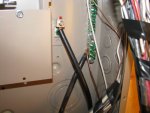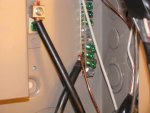redikillowatt
Member
- Location
- TX
New home construction (in county - no inspectors) w/ a new Cutler-Hammer 200 A service entrance (residential).
No other sub panels.
This panel has separate ground buss - shown in pics. I assume the (split) neutral & ground buss are bonded together, but didn't take a pic.
1) If the neutral & grd buss must be directly bonded, what size conductor is required for 200 A load center?
Pics show one GEC connected to a lug, screwed to panel box. Another (2nd) GEC is connected to ground buss.
One GEC goes to what was someone's intention to be a Ufer grd (but isn't). It's only 3/8" rebar, & slab has plastic vapor barrier under & up side of slab.
2nd GEC goes directly from panel to a driven 8 ft galvanized rod.
2) Does NEC allow using a lug screwed to the panel for a GEC, or should all GECs (if more than one) be connected to ground buss? It would seem for a GEC, there needs to be more contact than a screw through sheet metal. Although the box is grounded, that set up is dependent on the box being part of the grounding path - to & thru the GEC.
Thanks.
No other sub panels.
This panel has separate ground buss - shown in pics. I assume the (split) neutral & ground buss are bonded together, but didn't take a pic.
1) If the neutral & grd buss must be directly bonded, what size conductor is required for 200 A load center?
Pics show one GEC connected to a lug, screwed to panel box. Another (2nd) GEC is connected to ground buss.
One GEC goes to what was someone's intention to be a Ufer grd (but isn't). It's only 3/8" rebar, & slab has plastic vapor barrier under & up side of slab.
2nd GEC goes directly from panel to a driven 8 ft galvanized rod.
2) Does NEC allow using a lug screwed to the panel for a GEC, or should all GECs (if more than one) be connected to ground buss? It would seem for a GEC, there needs to be more contact than a screw through sheet metal. Although the box is grounded, that set up is dependent on the box being part of the grounding path - to & thru the GEC.
Thanks.



